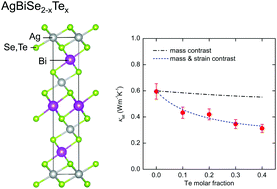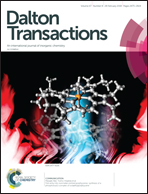Effect of Te substitution on crystal structure and transport properties of AgBiSe2 thermoelectric material†
Abstract
Silver bismuth diselenide (AgBiSe2) has attracted much attention as an efficient thermoelectric material, owing to its intrinsically low lattice thermal conductivity. While samples synthesized using a solid-state reaction showed n-type conductivity and their dimensionless figure of merit (ZT) reached ∼1 by electron doping, theoretical calculations predicted that a remarkably high thermoelectric performance can be achieved in p-type AgBiSe2. In this paper, we present the effect of Te substitution on the crystal structure and thermoelectric properties of AgBiSe2, expecting p-type conductivity due to the shallowing of the energy potential of the valence band. We found that all AgBiSe2−xTex (x = 0–0.8) prepared using a solid-state reaction exhibits n-type conductivity from 300 to 750 K. The room-temperature lattice thermal conductivity decreased to as low as 0.3 W m−1 K−1 by Te substitution, which was qualitatively described using the point defect scattering model for the solid solution. We show that ZT reaches ∼0.6 for x = 0.8 at a broad range of temperatures, from 550 to 750 K, due to the increased power factor, although the carrier concentration has not been optimized yet.



 Please wait while we load your content...
Please wait while we load your content...